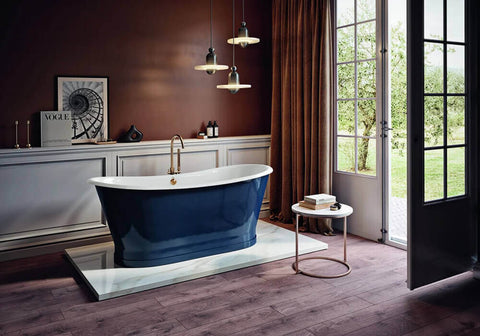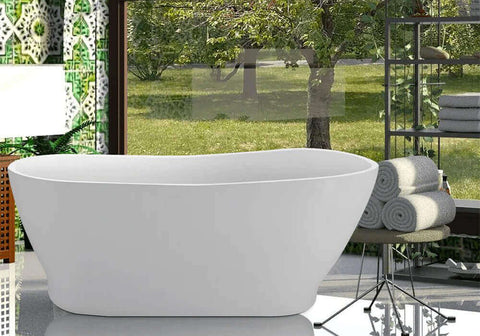Bathtubs symbolize comfort and offer us a daily indulgence, transforming our bathrooms into sanctuaries where we can relax and unwind from the stresses of life. On the market, there's a variety of materials used to craft bathtubs, including ceramic, stone resin, fiberglass, acrylic, and cast iron. Each material has its unique characteristics, styles, comfort levels, and price points. So, among the plethora of choices, which material reigns supreme? In this article, we'll focus on comparing cast iron and acrylic, two common bathtub materials, to help you find the option that best suits your needs. Let's dive in!
What is a Cast Iron Bathtub

Cast iron is a form of iron that is produced by melting iron metal and mixing it with high-carbon materials, such as scrap iron, and then pouring the molten iron into molds for shaping. Early cast iron materials were primarily used for making troughs for horses, but later became one of the mainstream bathtub materials due to its durability and excellent heat conduction properties.
When casting bathtubs with cast iron, the focus is on using higher quality materials, typically gray cast iron. The material is then cut into appropriate sizes according to the bathtub's dimensions and melted in a furnace. When the temperature reaches the melting point of cast iron, it becomes liquid, and the molten cast iron material is poured into prepared molds and allowed to cool. Since it is an iron product, although it has a sturdy appearance, it is susceptible to acidic corrosion. Therefore, most cast iron bathtubs on the market are coated with enamel on the surface, which not only provides a certain degree of corrosion resistance but also enhances aesthetics and surface smoothness.
What is an Acrylic Bathtub

Acrylic, also known as PMMA (Poly(methyl methacrylate)), is a transparent thermoplastic polymer material known for its good transparency, chemical stability, and weather resistance, often used as a substitute for glass.
Before casting bathtubs with acrylic material, molds are typically made using fiberglass and unsaturated resin and finely polished to ensure the accuracy of the bathtub's shape and structure. Subsequently, acrylic sheets are placed in a high-temperature oven for heating and vacuum-formed onto the surface of the mold to form the overall shape of the bathtub. Once the bathtub is formed, resins, fiberglass, and other reinforcing materials are often used to reinforce the bathtub to improve its structural strength and durability. Finally, the bathtub surface is glazed and baked before finishing and polishing to further optimize the bathtub details.
Lifespan
In terms of lifespan, there's a significant difference between two types of bathtubs. Acrylic bathtubs are expected to last 10 to 15 years, while cast iron bathtubs can endure for a century! That's longer than most people live. However, this doesn't mean acrylic bathtubs are less reliable. By reinforcing them with fiberglass, acrylic bathtubs become quite sturdy, able to withstand various forces throughout their entire lifespan. Therefore, while acrylic bathtubs have a relatively shorter lifespan, their strength and reliability are still commendable.
Price
Due to their simple craftsmanship and relatively inexpensive materials, acrylic bathtubs are generally considered a more cost-effective option. On the market, you'll find acrylic bathtubs priced around $1300. However, at Giving Tree Home, we've managed to lower production costs through process optimization, so you can purchase acrylic bathtubs from us for less than $1000. On the other hand, the materials cost of cast iron bathtubs is higher, and casting them is more challenging, so their price often exceeds $1500.
Installation
Most cast iron bathtubs typically feature a freestanding design, meaning they can be installed in almost any area. However, the weight of cast iron bathtubs is an important factor to consider. Due to their substantial weight, more effort is required for handling and installation. Therefore, it's recommended to reinforce the ground in the installation area to ensure the support can withstand the bathtub's weight. In contrast, acrylic bathtubs are lighter and more flexible. They're easy to lift, install, and maneuver into the desired position and orientation. Regarding installation, acrylic bathtubs available on the market include freestanding and alcove types. If you prefer an easy-to-install option, we recommend purchasing an acrylic freestanding bathtub, as you only need to connect the pipes to the drain to start using it.
Style
When choosing a bathtub, acrylic bathtubs offer a more diverse range of options. Firstly, this is because acrylic bathtubs are more popular in the market, so more brands offer a variety of styles for consumers to choose from. Secondly, acrylic as a material has excellent flexibility, allowing manufacturers to easily create bathtubs of various shapes and styles to meet the needs and preferences of different consumers. In comparison, the selection of cast iron bathtubs is relatively limited, and their production is more challenging. Cast iron bathtubs typically exhibit a vintage style, which may appeal to some consumers, but it also means there's less variety in styles.
Insulation
This may be an easily overlooked but crucial factor when choosing a bathtub. Excellent insulation can provide users with a more comfortable bathing experience. Due to its dense nature and the enamel coating on the exterior, cast iron bathtubs have the best insulation performance among all bathtubs. If you enjoy reading or listening to music while soaking, we recommend using one. Although the insulation performance of acrylic bathtubs is not as good as that of cast iron bathtubs, there's no need to worry too much as they still maintain water temperature for a certain amount of time.
Cleaning
For cast iron bathtubs, the enamel coating makes cleaning very easy. You can easily maintain the cleanliness of the bathtub by using soap and water, without worrying about mold or grime buildup. In contrast, acrylic is more prone to wear and tear, so you should be careful when cleaning it. Giving Tree Home always recommends using gentle cleaning products instead of abrasive cleaning methods for acrylic bathtubs. Additionally, to keep your acrylic bathtub shiny and clean, it's recommended to perform simple maintenance every two weeks to remove debris and stains.
Ending
Overall, acrylic bathtubs offer certain advantages in terms of aesthetics, convenience, and cost, making them a preferable choice for users who value flexibility, convenience, and modern decor. On the other hand, cast iron bathtubs have an edge in terms of reliability, serving as a dependable long-term investment in bathroom fixtures.






